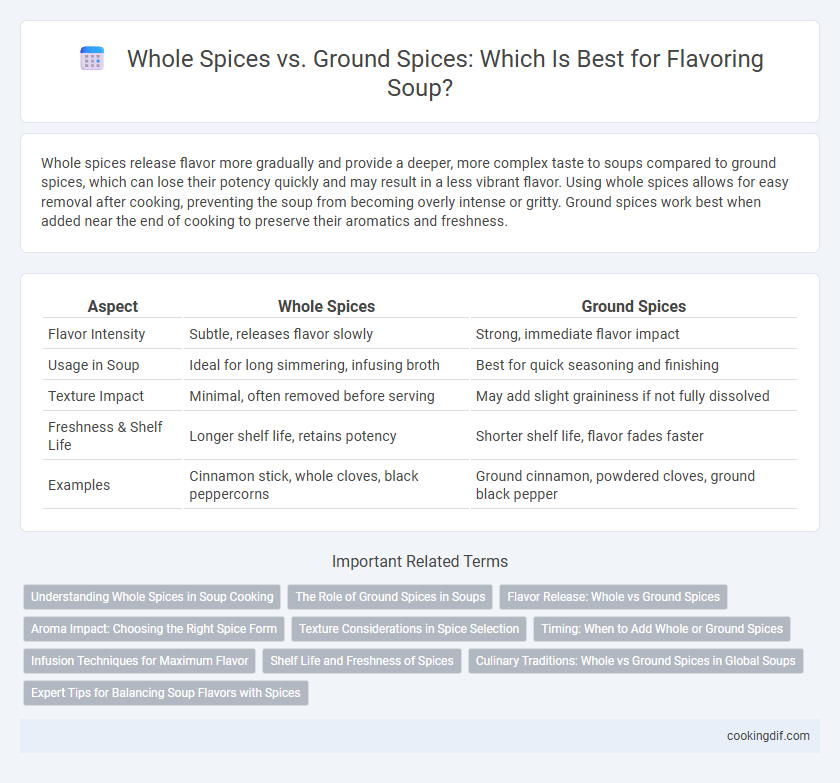Whole spices release flavor more gradually and provide a deeper, more complex taste to soups compared to ground spices, which can lose their potency quickly and may result in a less vibrant flavor. Using whole spices allows for easy removal after cooking, preventing the soup from becoming overly intense or gritty. Ground spices work best when added near the end of cooking to preserve their aromatics and freshness.
Table of Comparison
| Aspect | Whole Spices | Ground Spices |
|---|---|---|
| Flavor Intensity | Subtle, releases flavor slowly | Strong, immediate flavor impact |
| Usage in Soup | Ideal for long simmering, infusing broth | Best for quick seasoning and finishing |
| Texture Impact | Minimal, often removed before serving | May add slight graininess if not fully dissolved |
| Freshness & Shelf Life | Longer shelf life, retains potency | Shorter shelf life, flavor fades faster |
| Examples | Cinnamon stick, whole cloves, black peppercorns | Ground cinnamon, powdered cloves, ground black pepper |
Understanding Whole Spices in Soup Cooking
Whole spices release their essential oils slowly, offering a more nuanced and complex flavor profile in soup compared to ground spices. Their intact structure helps maintain freshness longer and allows for controlled infusion during simmering. Common whole spices for soup include cinnamon sticks, cloves, and cardamom pods, which enhance aroma and depth without overpowering the dish.
The Role of Ground Spices in Soups
Ground spices release their essential oils quickly, intensifying the flavor of soups in a shorter cooking time. They blend seamlessly into the broth, creating a smooth and consistent taste profile throughout the dish. Using ground spices enhances aroma while offering better control over the seasoning intensity compared to whole spices.
Flavor Release: Whole vs Ground Spices
Whole spices retain their essential oils and flavor compounds longer, releasing flavors gradually during the cooking process. Ground spices have a larger surface area, allowing for immediate and intense flavor release but tend to lose potency quickly when exposed to air. For soups, using whole spices infuses a deeper, layered aroma over time, while ground spices offer an instant burst of flavor that can diminish if overcooked.
Aroma Impact: Choosing the Right Spice Form
Whole spices release their essential oils slowly, providing a more complex and lasting aroma in soups compared to ground spices, which can lose potency quickly. Crushing or toasting whole spices before adding them intensifies their fragrance and enhances the overall flavor profile. Ground spices offer immediate impact but tend to dissipate faster, making whole spices ideal for simmered soups that develop richness over time.
Texture Considerations in Spice Selection
Whole spices in soup provide a gradual release of intense flavors and maintain a distinct texture that can enhance the overall mouthfeel, while ground spices dissolve quickly, offering immediate flavor but potentially altering the soup's smoothness. Using whole spices like cinnamon sticks, cloves, or peppercorns allows for easy removal after cooking, preserving a clean texture without grittiness. Ground spices are better suited for soups where a uniform texture is desired, but care must be taken to avoid sediment or a powdery consistency.
Timing: When to Add Whole or Ground Spices
Whole spices release their flavors slowly and are ideal for long simmering periods in soups, allowing deeper infusion over time. Ground spices disperse quickly, making them best added towards the end of cooking to preserve their vibrant aroma and distinct taste. Timing the addition of whole versus ground spices significantly impacts the soup's flavor balance and intensity.
Infusion Techniques for Maximum Flavor
Whole spices release flavor gradually during long simmering, making them ideal for soups that need extended cooking times to develop rich, complex aromas. Ground spices disperse quickly, providing an immediate burst of flavor but often losing potency over time in soups. Using whole spices in a spice sachet or bouquet garni allows for easy removal while maximizing infusion, ensuring a balanced and intense flavor profile.
Shelf Life and Freshness of Spices
Whole spices retain their essential oils longer, preserving freshness and flavor intensity in soups for up to four years when stored properly. Ground spices have a shorter shelf life, typically losing potency within six months to a year due to increased surface area exposure to air and moisture. Using whole spices and grinding them just before adding to soup ensures optimal flavor and aromatic quality.
Culinary Traditions: Whole vs Ground Spices in Global Soups
Whole spices release flavor more slowly, making them ideal for long-simmered soups in culinary traditions like Indian and Moroccan cuisines, where gradual infusion enhances depth and complexity. Ground spices provide immediate, intense flavor, commonly used in quick-cooked soups such as Mexican or Thai varieties to boost aroma and spice levels swiftly. The choice between whole and ground spices reflects regional preferences and cooking methods, impacting the texture and layering of flavors in global soups.
Expert Tips for Balancing Soup Flavors with Spices
Whole spices release flavors gradually, making them ideal for long-simmering soups, while ground spices infuse quicker but can overpower if used excessively. Expert chefs recommend toasting whole spices before adding to enhance aroma and removing them after cooking to avoid bitterness. For balanced soup flavors, combine a small amount of ground spices for immediate impact with whole spices for deep, layered taste.
whole spices vs ground spices for flavoring Infographic

 cookingdif.com
cookingdif.com